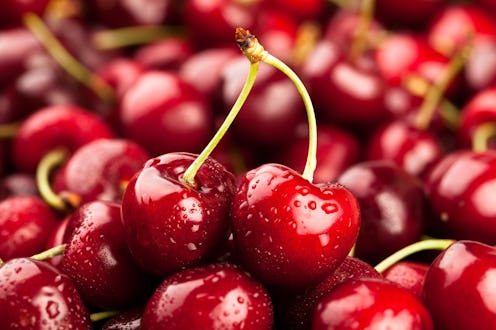Life
This Is What Having New Bumps On Your Nipples Could Mean For Your Health
Is there any woman in the world who hasn't looked at her nipples one morning and thought, "That wasn't there yesterday"? Luckily, many changes in your nipples are usually benign, and many aspects — from the small bumps on your nipples to hair — are completely normal, and nothing to be concerned about. If you're experiencing pain, abnormal discharge, or other symptoms, it's worth scheduling a check-in with your doctor — but for the most part, the bumps on your nipples can tell you a lot about your general health, if you're paying attention to them.
The bumps, as it happens, are called Montgomery's glands, according to Healthline. They are sebaceous glands that release oil to lubricate the delicate skin of the nipple — extremely helpful if they're being used for breastfeeding, for example, or they're just rubbing up against an uncomfortable bra.
Generally speaking, experts say that if your nipple has changed appearance radically and you don't know why — and there's no lifestyle change, like a new laundry detergent, that may have caused it — you should go see your doctor ASAP. While very few nipple symptoms turn out to be breast cancer, oddity in the nipple department still needs to be diagnosed and dealt with properly. Nobody's got time for suffering areolae.
1Scaliness Can Mean You've Got Jogger's Nipple
If your nipple looks "scaly," like lizard skin, and itches, you may have a problem known as "jogger's nipple," according to WebMD. That glamorous name indicates how it forms: because of friction against bras and other materials, which dry out and irritate the delicate nipple surface and make it hard and inflamed. Fortunately the chafing issue is usually pretty easily solved with some lubrication; professional runners often use petroleum jelly while exercising, and antiseptic cream is suggested while your nipple is recovering to prevent the dry, broken skin from getting infected. If it keeps recurring even when there's no obvious source of friction, you may have nipple eczema, so keep an eye on it and go see a doctor.
2Sudden Reddening Can Indicate Paget's Disease
Nipples are pretty sensitive and can get irritated for a variety of reasons. However, if your nipple has suddenly reddened for no apparent reason, won't calm down, and you can't think of any reason for it to happen, monitor it and make an appointment with your doctor. The reason? Paget's disease could be the issue. It's a rare type of breast cancer that centers on the nipple, and redness, along with stiffening of the nipple tissue and irritation, are early signs of it. If you're concerned, particularly if there's a history of breast cancer in your family, it's worth getting it checked out.
3Pimples Could Mean A Yeast Infection
If you're breastfeeding, you might run into a different kind of bump on your nipple: pimples. These pesky zits can be a simple case of blocked pores, but they can also be a sign of a yeast infection — yes, on your nipples. Otherwise known as candida or thrush, it's a condition that emerges when breasts have been in warm, moist environments for a while, whether that's in breastfeeding bras or while hiking in a wet season. Thrush on the nipples is usually pretty painful, so if you've just got a few stray pimples and no pain, it's unlikely to be the culprit.
4Darkening Nipples Are A Signal Of Hormonal Changes
Most women and men experience darkening nipples during puberty, as their adolescent hormones prompt shifts in the coloration of their nipple skin. If your nipples darken at other points in your life, though, it's not necessarily a cause for concern; hormones do alter throughout your life. Menstruation, taking oral contraceptives (or coming off them) and getting pregnant are all known causes of darkening nipples, according to Healthline, so if you're concerned about the color in the mirror, note where you are on your cycle and whether anything's changed in your reproductive regime lately.
5White Spots Can Indicate Your Bra's Too Tight
If you're breastfeeding and notice white spots on your nipples, the good news is that everything is probably fine. The bad news is that your bra is possibly too tight. In breastfeeding or pregnant women, milk ducts on the nipples can get blocked, causing a pimple-like blockage called (romantically enough) a bleb or milk blister. They're often the product of pressure on the nipple, meaning that you should look into your underwire situation and whether you're strapping anything to your chest at regular intervals. If you're not pregnant or breastfeeding, the spots could come from another source, like a skin infection; it's not really known for milk ducts to get clogged in women who aren't actually producing milk. Blebs can be treated by applying hot compresses, using a hospital-grade pump, or with medication, according to KellyMom.
6Suddenly Inverted Nipples Are Concerning
Some women have out nipples, others have innies. Like bellybuttons, this is just a fact of life and nothing to be worried about. However, doctors note that if a nipple suddenly switches from being convex to concave, it's something that needs to be checked out immediately. If you happen to be pregnant, that can be a common cause of inversion of the nipples, but if not, nipple inversion is occasionally a signal of breast cancer, as the tissue of the breast can retract and pull the nipple inward. If you notice that one nipple has suddenly turned into an innie, go see a specialist as soon as you can.
Nipples can handle rather a lot — it's not every body part that can cope with small babies latching on and using it for a food source — but it's still important to take care of 'em. And when they try to tell you something's wrong, listen.
